Rhomboid muscle of the back. Exercises for the rhomboid muscle of the back Rhomboid muscle training
Why do defined muscles make a person attractive? From an aesthetic point of view, the beauty of the body implies physical health.
Strong back muscles provide powerful protection to the spinal column, a complex organ that ensures the normal functioning of internal organs and is sensitive to disruptions in their functioning.

The strong rhomboid back muscle is located under, and thanks to it a person can freely maintain a beautiful straight posture. Antagonists are the pectoral muscles.
A weak rhomboid muscle leads to gradual shortening of the pectoral muscle. And then it’s very close to problems with the spine.
Functional Features
The rhomboid muscle received its name for its resemblance to a geometric figure. In the area between the shoulder blades on either side of the spine, muscle fibers stretch left and right, ending at the lower edge of the shoulder blades.
The muscle consists of 2 parts: the large rhomboid muscle covers the area from 1 to 5 thoracic vertebrae, the small muscle stretches from the 6-7 cervical vertebrae.
The large muscle pulls the shoulder blades toward the midvertebral line, and the small muscle rotates the lower corner of the shoulder blade inward during movements. These are their main functions.
Exercises for the rhomboid muscle group include many basic combinations that also involve other spinal muscles.
These muscle fibers are to some extent independent, since any efforts aimed at strengthening the muscular frame of the back simultaneously have an indirect effect on the rhomboid muscles.
A weak rhomboid muscle causes spinal pathologies in the thoracic region. The back hurts in this area due to the fact that the stretched muscle fibers no longer provide support to the vertebrae, the pressure on which increases.
With increased physical activity, a gradual flattening of the intervertebral discs occurs - and develop.
The problem is aggravated by the fact that the body compensates for the “powerlessness” of the rhomboid muscle by gradually shortening the pectoral muscle fibers.
And then, when a person tries to straighten his back, he cannot completely straighten his shoulders and involuntarily arches his back in the lower back, which is also subject to unnecessary stress.
Thus, a weakened rhomboid muscle becomes the cause of pathologies of the spine in its various parts. To properly pump these muscle fibers, you can perform a wide variety of exercises to strengthen your back muscles.
What movements should you perform?
The anatomy of the rhomboid muscle is designed in such a way that it is involved in almost all back strengthening exercises. You can choose movements that are simple in technique, but very effective. For example, these:

- I.p. – sitting, legs slightly apart. You need to sit at some distance from the back of the chair, bend your elbows. Elbows point down. The shoulder blades move towards each other. Having brought them to the closest possible distance, you need to linger for a few seconds.
- Good training also occurs when performing this exercise: from the i.p. – sitting, legs bent at the knees – place your hands on your knees in opposite directions. The left hand lies on the right knee, the right hand on the left. Make a slight tilt with your body forward, tilt your chin slightly down. Hold for a few seconds.
- Other effective exercises for strengthening the rhomboid muscle include movements that involve the shoulder blades. Bringing them together and spreading them, fixing the chosen position is a good training exercise for the specified muscle group. Fortunately, there are a lot of such variations and choosing the most suitable ones for yourself will not be difficult at all.
Before starting training, it would be a good idea to stretch your muscles using simple movements: walking with moderate swinging of your arms, stretching them, spreading them to the sides, lowering them down - warming up has a tonic, general strengthening effect. When the rhomboid muscles are warmed up, you can begin the main exercises.
Incorrect posture can sometimes cause quite painful sensations in a person. Regular, prolonged exposure to incorrect body position can cause pain in almost any area of the back. If a person strongly strains the muscles of the torso and does not take any measures to relax them, then in the end it is the back muscles that suffer first.
Pain between the shoulder blades in case of overstrain of the torso muscles is felt in the rhomboid muscle. This is due to her weakness. In order for the rhomboid muscle not to cause problems to a person, it is necessary to regularly maintain its tone - namely, to stretch and strengthen the muscle tissue between the shoulder blades.
The rhomboid muscle is located directly under the trapezius and is the connecting bridge between the scapula and the spine in the upper torso. It also takes part in connecting both shoulder blades to each other, along with the trapezius muscle. The rhomboid muscle is also responsible for raising the shoulder blades, holding them in a fixed position and connecting them to each other.
This back muscle is the curator of beautiful, correct posture. This is the main muscle that gives the shoulder blades a stable position at the back. This muscle tissue originates from the branches of the thoracic vertebrae of the upper part of the sternum and runs all the way to the lower angle of the shoulder blades, when viewed from top to bottom. The anatomy of rhomboid muscle tissue suggests its small and large varieties.
Table No. 1. Varieties of the rhomboid back muscle.
| Name | Description |
|---|---|
| Rhomboid major muscle | Its appearance is similar to a rhombus and is located under the trapezius muscle; the boundaries of its location are precisely the shoulder blades of the body. This type of rhomboid muscle starts from the first four vertebrae of the chest. Muscle tissue is attached to the lateral portion of these vertebrae, extending downward vertically to the axis of the spine. On the other hand, the rhomboid major muscle is attached to the middle edge of the scapula and to its lower corner. |
| Rhomboid minor muscle | It also has a diamond-shaped appearance and is located under the trapezius muscle. But small muscle tissue originates from the last cervical and first thoracic vertebrae. It is attached to the scapula similarly to the rhomboid major muscle, that is, to the middle and angular lower part of the scapula. |
Functional properties of the rhomboid muscle
The rhomboid muscles of the back allow the arms to move downward from an upright position. Such movements are often used by athletes involved in tennis, swimming (swimming technique - breaststroke), volleyball or handball. This muscle function is needed when extending the arms from the initial position, for example, when swimming crawl. In addition, the rhomboid back muscles provide stability to the shoulder part of the torso, and therefore play a huge role in sports such as artistic gymnastics or various types of shooting.
Causes of pain
Excessive stress on the rhomboid back muscle can lead to malfunction. This phenomenon may be accompanied by spasms and pain of varying intensity. In addition, excessive tension in muscle tissue can lead to limitation of motor functions of the shoulder region and cervical region of the body.
The cause of overload of the rhomboid muscle is often excessive physical stress on the upper limbs and shoulder area, namely:
- upward movements of the arms directly above the head. These can be loads when a person places something heavy on a surface high from the floor, or when serving in tennis;
- constantly wearing a heavy backpack or bag on one shoulder;
- movements during rowing;
- lifting heavy objects using improper technique.

As a result, the rhomboid muscle, which is constantly in good shape, weakens, which entails a change in the location of the shoulder blades. This occurs due to a series of muscle changes called upper crossover syndrome.
Another problem with the rhomboid muscles is overstretching them. This occurs as a result of the shoulder part of the back being constantly lowered. A clear result of this process in the back muscle tissue is stooping. Here there is strong passivity of the rhomboid muscle. In addition, when the back muscles are stretched, a process of shortening of the pectoral muscles opposite in location is also observed. Often this process of muscle tissue deformation can be observed in people who lead a sedentary lifestyle. And this often leads to even greater negative consequences in the form of osteochondrosis or cardiovascular diseases.
Also, a large stretch of the rhomboid muscle can be observed in people with tall stature. Sometimes, due to their internal complexes, they try to look shorter, and for this they constantly slouch, which ultimately leads to problems with the back muscles. A constantly bent position of the torso, namely the tension of the rhomboid muscles, provokes muscle spasm. The body, being regularly in a half-bent state, remembers it as natural, and over time it is no longer possible to straighten up.
Problems with the rhomboid back muscle
Weakening of the rhomboid muscle often occurs on both sides. In this case, the shoulders move forward and they become displaced, which results in the formation of a stoop. The opposite chest muscle undergoes a shortening process. And this, in turn, leads to compression of the blood vessels and nerves in this area, resulting in the appearance of pins and needles in the upper extremities. Another sign of shortening of the pectoral muscle is the incorrect position of the hands when they are freely lowered down. Visually, the hands will be turned with the outer side forward, and not to the side when viewed from the front.

A weak rhomboid muscle moves the scapula and the entire shoulder region forward, and this leads to shortening of the sternum muscles. In addition, after the shoulder part of the back is displaced, the patient’s neck and head take on an incorrect position. They also tend to move forward. This is due to the anatomical location of the cervical spine, which, like the rhomboid muscle, is attached to the upper part of the thoracic vertebrae. And in case of dysfunction of the rhomboid muscle, the extensor mechanism of the cervical spine begins to work incorrectly.
Often, weakening of the rhomboid muscle occurs due to overstrain of the pectoralis major muscle. It visually gives the human body an aesthetically attractive appearance. Therefore, when pumping this muscle, athletes often overload it, and end up with a stooped posture and a hunched figure. This occurs due to the fact that the overstrained pectoral muscle pulls the entire shoulder part of the back forward, and the rhomboid muscle of the back weakens, and pain begins to progress in it. Therefore, any human activity associated with bending forward and parallel bending of the shoulders leads to a weakening of the rhomboid muscle of the back and the appearance of pain in this area of the back.
The rhomboid back muscle is entirely responsible for the formation of beautiful posture, and its weakening disrupts this process. Often, weakening of the rhomboid major and minor muscle tissues leads to overload of the remaining working muscle, which doubles its load. In this case, the remaining healthy muscle tries to replace the work of the weakened ones, that is, to hold the shoulder blades and maintain their working functions. This leads to shortening and pain. But the largest percentage of cases occur when the entire group of rhomboid muscles as a whole weakens, which leads to a stooped person’s figure.
Being in a state of hunched back, a person wants to straighten his shoulders. Only this process, with weakened rhomboid muscles, occurs not due to the functioning of the extensors between the shoulder blades, but due to the lumbar muscles. This creates an excessive deflection in the lumbar area, which leads to pain in this area of the back. Therefore, in order to straighten up, the body does not use the problematic rhomboid muscle, but the healthy lumbar muscle.

Weakened rhomboid muscles can also lead to problems in the pectoralis minor muscle, as it tries to compensate for the work of the former. This leads to shortening of the sternum muscles. And this in turn leads to a number of breathing problems. Due to the fact that the pectoral muscle becomes shorter, improper fixation of the ribs occurs, which leads to limitation of motor functions, starting from the third to the fifth vertebrae of the body. The result of this process is a short breath, and this already leads to problems in the respiratory system of the body.
Diagnosis of disorders in the rhomboid muscle
Problems with the rhomboid muscle can be identified by pain that occurs in the shoulder blade area. The pain does not depend on the intensity of movement and can be felt by the patient even during rest, when the person is in a horizontal position. Painful sensations do not have a clear localization specifically in the rhomboid muscle - they are also felt in the muscles that compensate for the work of weakened muscle tissue. And as is already known, these muscles are the tissues of the lumbar back. That is why if a patient feels pain not only between the shoulder blades, but also in the lower back, experts do not rule out that the source of pain is the rhomboid muscle. To be sure of this, the patient must undergo appropriate examination to make an accurate diagnosis.
Treatment of rhomboid muscles
- Complete physical rest of the back muscles tends to reduce pain, because constant tense movements of the rhomboid muscle only increase pain.
- Applying ice during the first days of pain has a beneficial effect on the subsidence of pain. To do this, you need to take a sufficient number of pieces of ice, crush them and fill a plastic bag with them. When the ice pack is ready, you need to lower it to the floor, and the patient should take a horizontal position so that the ice pack is in the upper torso area. This procedure is recommended to be used every five hours, and the time a person lies on ice should not exceed twenty minutes.

- Heat treatment also gives good results in the fight against back pain. The main thing is that procedures using heat last no more than half an hour and are not used immediately before bedtime.
- Medicines are used in cases where pain is accompanied by inflammatory processes in the tissues of the rhomboid muscles. Their use is possible only after consultation with a doctor. Long-term use of medications is unacceptable due to their negative side effects.
- prescribed to patients with dysfunction of the rhomboid muscle, which has a long-term pain syndrome.

- stretching exercises have a high percentage of effectiveness in treating the rhomboid muscles. Thanks to this stretching of the muscle tissue, its activity is normalized, and the strength and flexibility of the rhomboid muscle increases, which helps to further prevent its damage.
The period of relief from pain and restoration of function of the rhomboid muscles completely depends on the severity and duration of the disease, as well as on the age of the patient and his general physical condition. Treatment of the disease at the initial stage of its development will require only a few weeks, and more severe and advanced cases must be treated for several months.
Video - Treatment of the rhomboid muscle from the point of view of acupuncture
Physical exercises to strengthen the rhomboid muscles
A positive feature of the rhomboid muscles is that they do not need to be trained as a separate group of muscle tissue, because they develop during physical activity on the entire back at the same time. Simply put, the rhomboid muscle will be stronger if the patient engages in even general back exercises. Below are the basic exercises to strengthen the back, as a result of which its component in the form of the rhomboid muscle will be restored and, over time, the pain in the upper part of the body will go away.
- To relieve pain and tension in the rhomboid muscle, you need to take a ball and position your body on the floor so that it is between the shoulder blade and the spine. The size of the ball for this exercise should correspond to the individual physique of the patient. Having placed the ball at the desired pain point, you need to completely relax the muscles of the whole body and lie there for several minutes. Next, do the same procedure for the second blade.
- You need to stretch your back muscles as follows. The patient sits on a chair and leans forward with his head bowed. Then the arms are crossed and the opposite knees are intercepted, that is, the patient takes the left knee with his right hand, and the right knee with his left. You need to stay in this position for up to thirty seconds.
- One of the effective physical exercises aimed at strengthening the rhomboid muscles is the boat and plank. With these exercises, both shoulder blades move towards each other, which contributes to the development of the problem area between the shoulder blades.
- A very simple exercise is the banal squeezing of the shoulder blades. The main thing is to do it correctly. To do this, the patient must stand up straight and straighten his back, while slightly lowering his chin. Then you need to move your shoulder blades back a little and fix the rhomboid muscle in tension for a few seconds. The procedure must be repeated at least nine times, two to three times a day.
- The exercise, which is recommended to be performed three times a week, is intermediate in nature and consists of the following: the patient lies on the floor, stretches his arms along the body and tries to bring the shoulder blades together, while simultaneously lifting the chest from the floor. During the exercise, you need to keep your neck as straight as possible. Having reached the final possible point when bringing the shoulder blades together, you need to fixate there for a couple of seconds, and then return to the starting position and relax. You need to do several approaches 10 times.
- It is recommended to perform exercises with a projectile no more than three times a week. It is performed from a sitting position on your knees, while your back should be straight. Next, grasping the projectile with his hands, the patient must slowly pull them back, while bringing his shoulder blades together. The position must be fixed for a few seconds and then returned to the starting point. It is recommended to perform two or three approaches ten times.

Physical exercises in the gym to strengthen the rhomboid muscle
- Movement of the block from the floor to the lower back from a sitting position. This exercise helps to significantly strengthen all back muscles as a whole. Sit on the simulator and take the handle of the projectile in your hands, while resting your feet on the special racks. In this position, the knees are bent and the body is vertical to the floor. The position of the lower back becomes similar to a deflection. Now you need to take a deep breath, and as you exhale, pull the handle of the exercise machine towards you all the way to your lower abdomen and return your body to a vertical position. For the greatest effect, it is necessary to bring the shoulder blades as close as possible to each other during the exercise.
- Movement of the block to the chest. This exercise is analogous to pull-ups on a horizontal bar, which allows you to make maximum use of the rhomboid back muscle. To perform this exercise, take the handle of the machine and sit on a special seat. Then, as you exhale, pull the block towards you to the point of the upper part of the sternum, slightly tilting your body back. As you inhale, you need to return to the starting point. While pulling the projectile towards you, move your chest towards the handle, and bring your shoulders behind you as much as possible.
- Pull-ups on the horizontal bar involve many back muscles, which is very effective for strengthening the rhomboid muscle, which is involved along with the rest. To perform this exercise, you need to grab the bar so that your hands are much wider than the ends of the shoulder part of the body. Next, you need to pull yourself up, trying to get your chest to touch the bar of the horizontal bar. Having achieved your goal, you need to return to the starting point. When pulling up, your back should arch slightly and your head should look up.
- The bent over movement with a dumbbell is good for strengthening the central and upper torso. To perform this exercise, you need to place your left kneecap on a bench or any support, and then rest your hand there, with your torso positioned almost parallel to the floor. In this pose, a deflection of the lumbar back is formed, and the right leg stands on the floor. Next, with your right hand, as you exhale, pull the projectile to the lower abdomen, and while inhaling, return to the starting point. For greater effect, you should try to perform the exercise using your back muscles, not your arms.
- The movement of the block to the stomach occurs on the simulator from a sitting position. The load is pulled as you exhale. At this moment, you need to straighten your chest and point your elbows back. As you inhale, we return to the starting point. The main thing with this exercise is that the movements are smooth, without sudden lunges.
- Exercise with a barbell. You need to grab the barbell with your hands, wider than your shoulders, and lean forward slightly with your legs bent. As you inhale, reach the barbell to your lower abdomen, and as you exhale, return to the original position.

For athletes who train muscles professionally, for example, bodybuilders, it is necessary to devote as much time as possible to stretching exercises for the back muscles in order not to overload them, as well as to prevent problems with the rhomboid muscles, since such people are most susceptible to such pathologies.
Let's sum it up
The rhomboid muscle of the back performs the most important functions, therefore, if pathologies concerning it occur, a person loses the opportunity to live fully. For this reason, it is necessary to get rid of the causes of diseases as early as possible. This will be helped by physical exercise and the simultaneous use of medications that will help relieve pain and muscle tension. If the treatment is carried out correctly, under the supervision of a specialist, then you will be able to forget about pain and problems with movement forever.
Proximal attachment of the spinous processes of the C7-T5 vertebrae.Distal attachment, Medial border of the scapula.
Function. Raise the shoulder blade while bringing it closer to the spine.
Palpation. To localize the rhomboid muscles, the following structures must be identified:
. Medial edge of the scapula.
. The base of the scapula is a small triangular surface located at the medial border of the spine of the scapula. Most often it is at the same horizontal level with the third thoracic vertebra.
. The inferior angle of the scapula is a triangular surface in the distal part of the scapula. Most often it is at the same horizontal level with the seventh thoracic vertebra.
. Spinous processes of the C715 vertebrae.
Place the patient on his stomach with his head resting comfortably on the pillow. Ask the patient to place their hands on the lower back, palms up. As he begins to lean his upper body back against the resistance created by your arm, the rhomboid muscles will become visible.
Palpate the rhomboid muscles in the space between the spinal column and the medial edge of the scapula as much as the fibers of the trapezius muscle.
Pain pattern. The pain is concentrated along the medial edge of the scapula, but can also spread laterally through the supraspinous part of the scapula. Local superficial aching pain is felt at rest and does not depend on movements.
Causal or supporting factors. Chronic overload caused by prolonged periods of working in a hunched position. Postural overload due to excessive contraction of the pectoralis major muscle.
Satellite trigger points. The levator scapulae, trapezius, supraspinatus and pectoralis major muscles.
Affected organ system. Respiratory system.
Associated zones, meridians and points.

Dorsal zone. Bladder foot meridian tai yang. BL 11 - 15, BL 41 - 44.

Stretching exercise. Sit on a chair. Bend forward with your head down, cross your arms in front of you and clasp your knees on opposite sides. Fix the pose to a count of 5 10.
Strengthening exercise. Lie diagonally across a table or bed and hang your arms over the edge. Bend your elbows 90 degrees, retract your shoulder blades and hold the pose until you count 10. Relax and repeat the exercise.
D. Finando, C. Finando
Back pain often accompanies people with poor posture. Staying in an incorrect position for a long time can lead to pain almost anywhere in the body. The muscles are the first to react to such inconveniences, especially if a person working in a sitting position causes them to overstrain day after day and does nothing to relax the muscles. A weakened or strained rhomboid back muscle is a common source of pain between the shoulder blades. To maintain this anatomical structure, which is also called the anti-slouch muscle, in shape it is necessary to stretch and strengthen the rhomboid muscle.
Exercises to strengthen and stretch the rhomboid back muscle
Each muscle in the human body performs a specific function. Thus, the rhomboid back muscle, consisting of two parts (minor and major), allows us to:
- stabilize the position of the shoulder blades;
- move the shoulder blades closer to the spine;
- maintain correct posture;
- raise the inner edge of the shoulder blade.
Unfortunately, overstrain of this muscle is by no means uncommon, especially among people who can sit at a laptop for days on end, slouching and holding their arms up.
Before starting any exercises, it is better to consult a doctor, because pain in the upper back can occur not only due to overstrain of the rhomboid back muscle, but also in the case of various diseases.
If, after an examination, the doctor has concluded that you need to strengthen your rhomboid muscle, we suggest you try the following exercises.
Basic exercise
This movement is simple, but to achieve the effect, you must first perform it at least 3 times a day. A gradual increase in the number of repetitions, frequency or duration of the exercise is possible provided there is no pain.
How to do it:
- stand or sit with your back straight;
- lower your chin slightly;
- move your shoulder blades back slightly;
- Slowly tighten the rhomboid muscle, bringing your shoulder blades together as far as possible without causing pain;
- hold your shoulder blades in this position for 5 seconds;
- repeat 10 times.
Intermediate exercise
The frequency of performing this exercise is 1 - 3 times a week, provided that it does not cause pain. As with the basic exercise, the frequency, number of repetitions and approaches can be increased if the movement is not accompanied by pain.
How to do it:
- lie on your stomach;
- arms are located along the body;
- tighten your rhomboid muscle by squeezing your shoulder blades together and slowly lifting your chest off the floor;
- keep your neck straight;
- at the end point, hold for 2 seconds;
- slowly return to a lying position;
- Your goal is 3 sets of 10 reps.

Exercise with an expander
The frequency of execution, as in the previous exercise, is from 1 to 3 times a week. For this exercise you will need an expander.
How to do it:
- get down on your knees, keeping your back straight (can also be done in a standing position);
- grab the expander as shown in the picture below;
- slowly pull your arms back, bringing your shoulder blades together;
- hold for 2 seconds;
- slowly return to the IP;
- perform 3 sets of 10 times.

Pain caused by overstrain of the rhomboid muscle, in addition to stretching exercises, can be relieved by massage.
To strengthen the rhomboid back muscle (provided there are no obvious problems), exercises that work the upper back are also suitable, i.e. dumbbell and barbell rows, pull-ups, swimming.



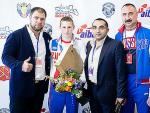

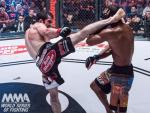
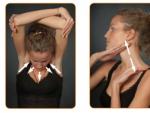
 What is compression clothing
What is compression clothing Cyclones and anticyclones Flettner's wind ship
Cyclones and anticyclones Flettner's wind ship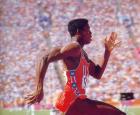 Fastest man in the world
Fastest man in the world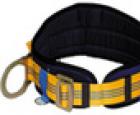 Descenders for industrial mountaineering Unicender - created by the Anglo-American company Morgan&Thompson
Descenders for industrial mountaineering Unicender - created by the Anglo-American company Morgan&Thompson